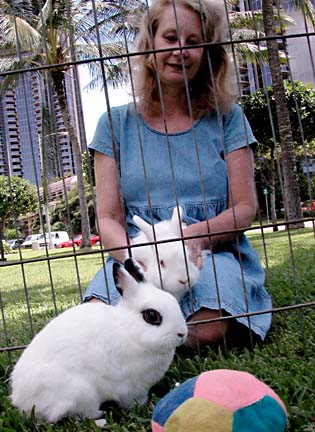
CRAIG T. KOJIMA / CKOJIMA@STARBULLETIN.COM
Rabbit enthusiast Cinde Fisher's favorite accommodation for her rabbits is a puppy playpen, because it is easy to maintain and offers plenty of room to run and perform "binkies" -- joyous leaps into the air. Fisher is holding Anela, while Peepers checks out the pen, set up temporarily outdoors.
At Easter time, it's mighty tempting to surprise a loved one with a baby rabbit, and we sometimes think the tinier that little ball of fluff, the more he'll be appreciated and adored. Pet stores and rabbit club displays outdo themselves at this time of year, displaying baby Netherland Dwarf rabbits -- the smallest recognized breed with an adult weight of 2.5 pounds.
If you're considering a rabbit
as an Easter gift, read this firstBy Cinde Fisher
Special to the Star-BulletinBut before giving in to your child's whims, consider whether the whole family is ready to have another living creature -- with its own demands and health needs -- to care for.
Unknowing consumers have no idea that few, if any, pet stores have the expertise to discern between a purebred and a poi, and stores may be incorrect in determining the bunny's breed, age or sex. If you've got your heart set on a bunny that will remain small into adulthood, you may be disappointed when he starts growing beyond your expectations.
And your heart may be broken when that tiny bunny that looked so cute in the Easter display develops problems exhibited by bunnies weaned too early, typically between four and six weeks. Ensuing veterinary bills and the stress of nursing or losing a sick pet may lead to a rude awakening. This is why humane and rescue groups, such as House Rabbit Society, never endorse the purchase of early weanlings.
Early-weaned bunnies appear healthy, but there are sound reasons why a baby is not separated from its mother so soon. A baby bunny is actually eating on its own at 2 1/2 weeks, well before the eight-week "safe" window of weaning. But like a human "preemie," health and development problems can ensue and result in a rapid decline.
CRAIG T. KOJIMA / CKOJIMA@STARBULLETIN.COM
Peepers, left, is a Dwarf Hotot, a breed known for "eye liner" markings that circle and accentuate its eyes. Pepper's pen mate is Anela, a Jersey Wooly Poi.
Mother bunnies are not noticeably attentive to their young in that they nurse only once or twice daily for about five minutes. They do not stay in the nest and cuddle with their young, an innate behavior that is due to their prey status: in the wild, a mother bunny lingering with her young draws the attention of predators.
Because of this somewhat indifferent attitude, it can be tempting to separate mother from babies too early. But by allowing the kits (babies) to remain with the mother and/or siblings for a full eight weeks, bunnies develop less stressfully and learn behaviors essential to normal and healthy survival.
The most common cause of death in rabbits weaned too early is mucoid enteritis, typical signs of which are diarrhea, lethargy, loss of appetite and a swollen or bloated abdomen. The stress of early weaning, change of diet and transportation and housing in pet shop or new home are all contributing factors, and, unfortunately, mortality is common. Loose, small or few droppings are also signs of serious digestive upset that can cause a swift demise.
The proper diet
Rabbits have one of the most complex and sensitive digestive systems of any herbivore. Diarrhea can kill in 24 to 48 hours.An improper diet may involve an abrupt change in food (including a change in brand of pellets); too much food too soon (particularly veggies); "junk" foods such as pellet feeds mixed with cereals and any other starches, carbohydrates or sugars, such as bread, cookies, cereal, crackers, seeds or nuts. These foods may upset the normal bacteria in a rabbit's system and encourage the growth of bacteria.
Unfortunately, rabbits crave sugary or salty foods and love these treats. The correct diet for any rabbit is cheap and easy: fresh water changed daily, a good-quality plain (unmixed) pellet, fresh dark-green leafy veggies and fresh Timothy hay, in unlimited quantities, the latter being the most critical factor in a healthy diet.
One of the most common errors made by new as well as experienced rabbit owners is the belief that hay is a treat, when in fact it is essential because of its high quantities of fiber, which keeps the animal's digestive system moving.
This is one of the reasons rabbits are not kept from eating prior to surgery, as are humans and some other animals. To do so might slow or throw the digestive system into "stasis" as well as render the rabbit weak. Because rabbits are incapable of vomiting, that common risk with anesthesia is eliminated, and we can further appreciate why an informed understanding of the bunny's tummy is so important.
Rebellious teens
Owners may think that if they have only a single rabbit, spaying or neutering is unnecessary. In fact, the procedure is done for the same health and behavioral reasons it's done for dogs and cats: It makes for a calmer, less aggressive animal, contributes substantially to overall health and reduces pet overpopulation. An un-spayed, nonbreeding female rabbit has an 80 percent probability of uterine cancer, typically seen between the ages of 2 and 5 years.The single most common reason rabbits are given up as pets is aggressive or unruly behavior seen at the time of sexual maturity, at age 4 months in the male and 6 months for females. At this time they become rebellious "teenagers," testing their humans' patience, acting out and mating with everything from stuffed toys to the living room couch. This is the result of blossoming hormones, and is easily corrected by spaying or neutering.
The operation can be costly (on Oahu, from $100 for males to more than $250 for females), and the veterinarian should be chosen with great care. The field of veterinary "exotics," and particularly that of companion rabbit medicine, is relatively new and has little to do with canine or feline medicine.
The comical, rascally and affectionate behavior bunnies are capable of is most commonly seen when they are kept in close proximity as a "house rabbit," rather than when kept outdoors in a lonely hutch or tiny cage. Rabbits are very social creatures and naturally curious. They enjoy spending time with their humans and can learn to come when called, especially at feeding time when they listen for the sound of the pellet or veggie bag!
They can be litter-trained and will play with toys, which must be chosen with care for safety. Sudden loud noises easily frighten rabbits, so the cage should never be placed close to loud televisions, stereos or barking dogs.
Keep 'em chewing
Rabbits have a physical and psychological need to chew, as their teeth keep growing and need to be worn down. When they attempt to nibble your valuables, they are not necessarily being bad, but are in fact engaging in innate behavior. Their teeth can wear unevenly if not afforded the proper diet and chewing materials.Topping their list of desired chewies is electrical cords, but anything that a bunny can get hold of is subject to chewing. Knowledgeable owners "bunnyproof" their homes, just as parents of toddlers must protect their children from hazards. Rabbits cannot be disciplined and should never be hit. The source of temptation must be removed and appropriate chewables substituted. A list of safe bunny toys and bunnyproofing hints may be found on a good companion rabbit Web site, such as that of the House Rabbit Society, www.rabbit.org.
The appropriate housing for any rabbit is as large and roomy an enclosure as your home can afford, and my favorite is a puppy playpen because of its low maintenance, generous running and jumping space and confined quarters. Rabbits require exercise, and lack of it leads to a bored rabbit prone to destructive behavior or obesity.
Rabbits also cannot tolerate heat, so the ambient temperature should not exceed 85 degrees. They should be kept in the coolest part of house or porch, never in direct sunlight, and away from rain, wet flooring and other damp areas. Exposure to temperatures that are too high can lead to life-threatening heat stress.
Rabbits exhibit a unique behavior, nicknamed a "binky" -- a joyous leap straight into the air, performed when they experience a sudden rush of energy or delight. They are affectionate and will "present" themselves, head down, for stroking, head rubs and snuggling.
Rabbits are also a commitment and should never be adopted on impulse, but rather to be loved as part of the family. As such, given the right care, feeding and love, they can provide you with 10 or more of the best years of your life!
Cinde Fisher has run the BunnyCares Workshops, now
in their fourth year, to educate the public on the proper
care of house rabbits. The workshops are available to any
school, business or community group. Call 381-5545.
Part of the 23rd annual Easter Anthurium Plant Show and Sale BunnyCares Workshop
Place: Ward Warehouse
Class time: 10 a.m. to 4 p.m. Saturday
Admission: Free
Call: 381-5545
"House Rabbit Handbook: How to Live with an Urban Rabbit," 3rd edition, by Marinell Harriman (Drollery Press) Suggested reading
"Rabbits for Dummies," by Audrey Pavia (Hungry Minds)
Click for online
calendars and events.



